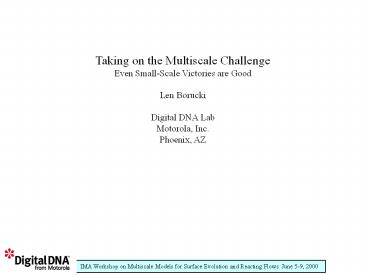Taking on the Multiscale Challenge - PowerPoint PPT Presentation
1 / 13
Title:
Taking on the Multiscale Challenge
Description:
Title: No Slide Title Author: Motorola Last modified by: IMA Created Date: 5/25/2000 8:56:08 PM Document presentation format: On-screen Show Company – PowerPoint PPT presentation
Number of Views:25
Avg rating:3.0/5.0
Title: Taking on the Multiscale Challenge
1
Taking on the Multiscale Challenge Even
Small-Scale Victories are Good Len
Borucki Digital DNA Lab Motorola, Inc. Phoenix,
AZ
2
Why do multiscale modeling? - Perspective from
semiconductor manufacturing.
0.2 m
0.1 mm
Deposited Film
wafer
T Merchant
Typically, tool knobs control tool physics on
the 0.1-1 meter scale
However, the goal is to control an outcome at the
micron scale or below over a wide area of the
wafer.
Tools are expensive, so optimizing their use is
important.
3
Several spatial scales may be involved.
1 cm
Equipment or Wafer Scale
Die (Chip) Scale
Feature Scale
Differences in feature packing densities within a
die or across a wafer may affect local feature
scale uniformity due to depletion of reactants or
other effects related to feature density.
4
(No Transcript)
5
Starting at the atomic level, the goal of
modeling may be to predict structure and
properties at much larger length and time scales.
There are huge gaps.
Void Nucleation
Electronic properties
Film thickness 10-9-10-8 m
D. Richards
A. Korkin, N. Tanpipat
10-10 m and 10-12 sec Film precursors. Gas
phase and surface chemistry.
Metal Lifetime
C-L Liu
Film nucleation, growth, grain structure and
transport properties.
10-9 - 10-5 m and 102 sec
10-4 - 10-3 m and 104 - 108 sec
6
Challenge Film Nucleation, Growth
Grain Nucleation (FCC nuclei with 100, 111 or
110 facets, randomly rotated and cut)
Isotropic Source
Grain growth for an isotropic or
unidirectional source. String algorithm, not
a level set method.
Source J. Zhang, J. Adams, Arizona State
University See http//ceaspub.eas.asu.edu/cms/
7
Challenge Calculation of properties of
polycrystalline structures.
8
Calculating transport properties of large
polycrystalline structures - an example.
This very simple model produces a fairly
convincing statistical failure time distribution.
9
Joule Heating in a Snake
IMA Workshop on Multiscale Models for Surface
Evolution and Reacting Flows June 5-9, 2000
10
A Different Reacting Flow Multiscale Problem
Chemical-Mechanical Polishing
A chemically reactive slurry containing 0.1 mm
particles is sprayed on a rotating polyurethane
pad in front of a rotating wafer. The
slurry attacks the surface layer on the wafer,
allowing the particles to more easily abrade
and smooth the layer.
11
Chemical-Mechanical Polishing
The polyurethane pad contains numerous voids
averaging 30 microns in diameter.
Voids exposed at the surface fill with slurry.
The slurry layer is very thin in highly
compressed areas between the voids. Slurry
particles probably contact the wafer in these
compressed regions.
12
Chemical-Mechanical Polishing
Shan, Georgia Tech
Somehow, this surface structure plays a role in
the details of the development of suction fluid
pressure under the wafer.
The suction pressure may in turn affect
the uniformity of the removal rate on the
wafer scale.
Question How to describe the pad surface and
utilize the information in a model with a longer
length scale eg. the Reynolds equation?
13
Summary
Multiscale models either Start at equipment
scale and connect with the feature scale.
Start at the atomic level and progress toward
longer length and time scales. Very significant
gaps exist, for example, Modeling of
nucleation and growth of polycrystalline films,
particularly in 3D and with topography.
Prediction of properties of polycrystalline
materials. Better mathematical and numerical
methods.






























